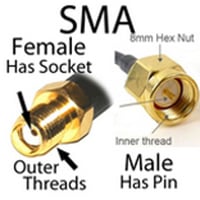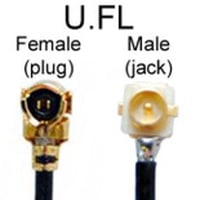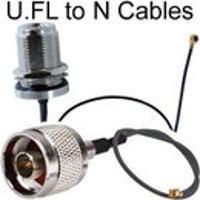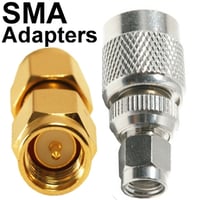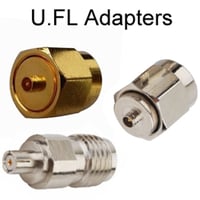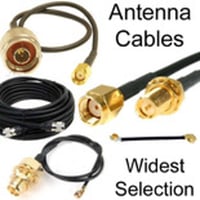U.FL to RP SMA Cables
RP-SMA to U.FL Connector Antenna Cables:
SEE LIST OF ARTICLES ABOUT U.FL CABLES AND CONNECTORS
The three types of coax that we use for U.FL cables are all impedance match to 50 Ohms:
Most of Data Alliance's U.FL to RP-SMA cables are made with 1.13mm coax (especially for shorter lengths): 1.13mm coax is a very thin and flexible cable, with a black jacket. While 1.13 coax is not the low-loss option, it is often very important to use this very thin and flexible coax for two reasons:
- In tight spaces (inside of cases and enclosures), such a thin coax is necessary to make tight bends. Often the size of the enclosure or case port is so small that it requires the use of 1.13 coax.
- The U.FL connector will snap down on the jack without popping off: 1.13mm coax is often required for this reason, because U.FL connectors on RG174 do have a tendency to pop off the jack, if not glued on.
1.32mm coaxial cable is just slightly thicker than 1.13: The added thickness is a second layer of braided shielding, for lower signal loss (attenuation). Therefore 1.32mm is an excellent option when very small diameter, extreme flexibility and low-loss are all needed. If you want us to make your cables with 1.32mm coax, please contact Customer Service and we will make the cables as a special order.
We can make special orders of U.FL cables with 1.32mm or 1.37mm coax, as well as RG174 (both of which are lower signal loss options) or 1.13mm cable, for better flexibility. 1.32mm is very thin and flexible, like 1.13 coax. 1.37mm is a double-shielded variant that is otherwise like 1.32mm.
All three of these coaxial cable types have a central wire (insulated by plastic) to conduct the RF signal, further surrounded by a braided mesh, shielding the conducting wire from electromagnetic interference. The double-shielded 1.32mm also includes a second , outer insulating layer that covers the conducting shield. The double-shielded design provides extremely efficient data transmission and where appropriately connected to an antenna the RF signal can be transmitted with minimal signal loss.
We use RG174 coax (2.54mm diameter) for longer lengths. RG174 has the lowest attenuation (signal loss) of the three coax types that are suitable for use with U.FL connectors.
We also offer adapters from U.FL to RP-SMA male and female: There is less signal loss when using an adapter than a cable.
We offer U.FL cables to RP-SMA female and RP-SMA male, with these features and options:
- RP-SMA female connectors have a bulkhead nut and washer, so that you can mount this connector in a port of a case or enclosure. For outdoor applications, you can add a rubber o-ring on the outside of the enclosure port to waterproof / weatherproof the connector to IP68 rating.
- The RP-SMA female connector can be either straight or right-angled.
- The RP-SMA male connector can be straight or right-angled.
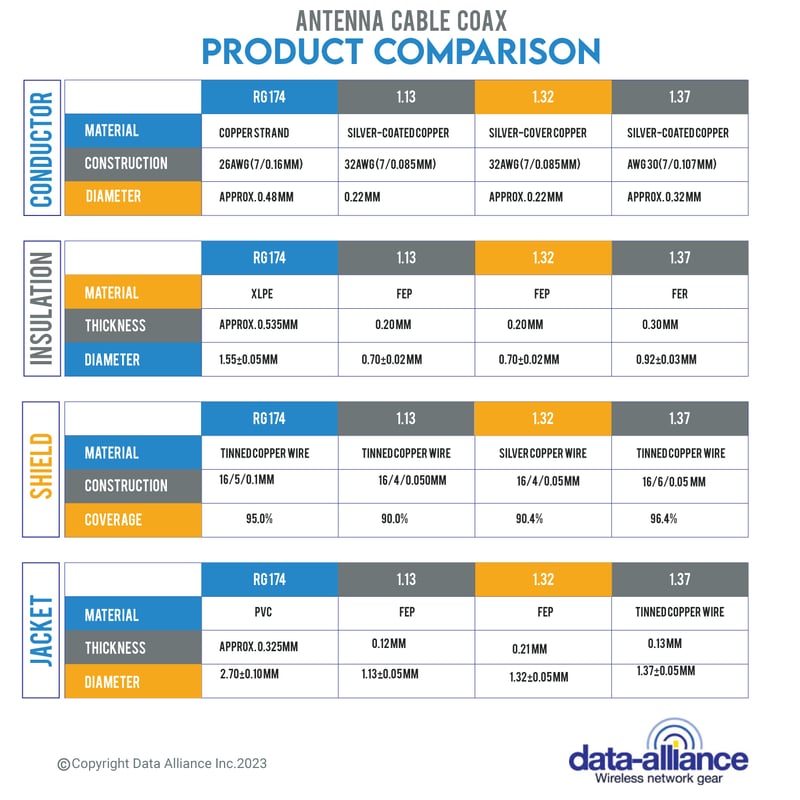
Our U.FL To RP-SMA cables consistently low broadband VSWR, range of frequency band compatibility (from 0GHz to 11 GHz)and 50 Ohms impedance matching, makes them suitable for all the following applications:
- Wi-Fi standards including both 2.4GHz and 5GHz applications: 802.11AC and the other WiFi protocols.
- Cellular Wireless: LTE, 5G, 4G, LETm, GSM, 3G
- IOT (Internet of Things) wireless protocols: Bluetooth, ZigBee, LoRa, M2M, RFID, NB-IoT.

RP-SMA connectors: A threaded, medium-sized, threaded and round screw type connector made for use from 0GHz (DC) up to 11GHz. Since it has very low broadband Voltage Standing Wave Ratio (VSWR), it has become one of the most common connectors that has found usage in all manner of applications.
The U.FL connector series are typically attached to the U.FL connector/jack on internal-PCI wireless cards and Printed Circuit Boards (PCB). Given their miniature size, they have found use in the IoT (Internet of Things) applications including Bluetooth beacons.
The female U.FL connector mates with the U.FL-LP-66 jack that is popular with Bluetooth beacons, mini-PCI wireless cards, and ZigBee radios such as XBee.
U.FL connectors / Antenna cables w/ U.FL connectors
The Hirose U.FL connector is a type of radio frequency (RF) connector used to connect coaxial cables. It is the smallest RF connector on the market.
- U.FL (sometimes called UMCC) is rated up to 6Ghz.
A U.FL connection stands only 2.5mm high when mated. The small profile and right-angle joint make it ideal for applications where space is at a premium - FOR EXAMPLE: to connect a WiFi antenna to a miniPCI card inside a slimline laptop.
- A U.FL cable may also connect to a GPS antenna or a Bluetooth Beacon.
Befitting a part that might end up in the chassis of a laptop, this connection is meant to stay put when mated. Snapping and unsnapping it several times will cause the female connector to wear out. It would then need to be replaced, along with the attached coaxial cable.
The male connector is usually soldered directly onto the circuit board as the jack: The jack is small enough to take up as little as 9mm x 9mm of space. The female connector snaps onto the male connector, secured by pressure from the metal snap structure.
A U.FL cable is can be made with a double-shielded 1.32mm coax. To fit in tight spaces, a thin and flexible 1.13mm coaxial cable may also be used. The largest antenna cable to feature U.FL is the 3mm RG174. Thicker but still flexible, the RG174 coax is not double-shielded and delivers less signal loss than its 1.32mm or 1.13mm counterparts.
The small size of U.FL and MMCX connectors has made them an excellent fit in Internet of Things (IoT) applications since they take up very little space in the cramped cases of small devices, such as Bluetooth beacons.
Compatible Wireless Protocols and Technologies
U.FL to RP-SMA cables are most typically used with these wireless protocols and technologies:
- Wi-Fi (802.11a/b/g/n/ac/ax)
- Bluetooth
- Zigbee
- Cellular Technologies (GSM, 3G, 4G, LTE)
- RFID and NFC
Torque Ratings
For RP-SMA connectors, a standard torque rating is around 3-5 in-lbs, ensuring a secure connection that minimizes the potential for damage and ensures signal integrity.
Key Features
- Compactness: U.FL connectors are known for their miniaturized form factor, making them ideal for applications with space constraints.
- Flexibility: The RP-SMA end allows for external antennas to be attached, extending the range and versatility of devices.
- Durability: These cables can withstand regular plugging and unplugging without significant wear and tear.
- Signal Strength: They facilitate optimal signal transmission, reducing signal loss.
Materials Composition
- Brass: Predominantly used for the body of the connectors due to its excellent conductivity and malleability.
- Gold Plating: Contacts are often gold-plated for enhanced conductivity and corrosion resistance.
- Teflon (PTFE): Employed as an insulator to prevent short-circuits and maintain signal integrity.
- Copper or Silver: Often used for the inner conductor of the cable to ensure efficient signal transmission.
Applications
- Laptops and PCs: For internal Wi-Fi cards to external antennas.
- Routers and Access Points: To connect to external antennas for better coverage.
- Drones and RC Devices: For better signal reception and transmission.
- IoT Devices: Linking internal modules to external antennas for improved connectivity.
Key Considerations
- Cable Length: A shorter cable usually results in less signal loss.
- Connector Quality: Gold-plated connectors typically offer better performance than nickel-plated ones.
- Application Requirements: Ensure the cable can handle the frequencies and power levels of your specific application.
Suitability for IoT Applications
U.FL to RP-SMA cable are particularly suitable in the Internet of Things (IoT) ecosystem due to:
- Space-Saving Design: U.FL's compactness is perfect for IoT devices.
- Versatility: RP-SMA allows for a range of external antennas, catering to various IoT environments.
- Robust Connectivity: Ensuring continuous and stable IoT device operation.

